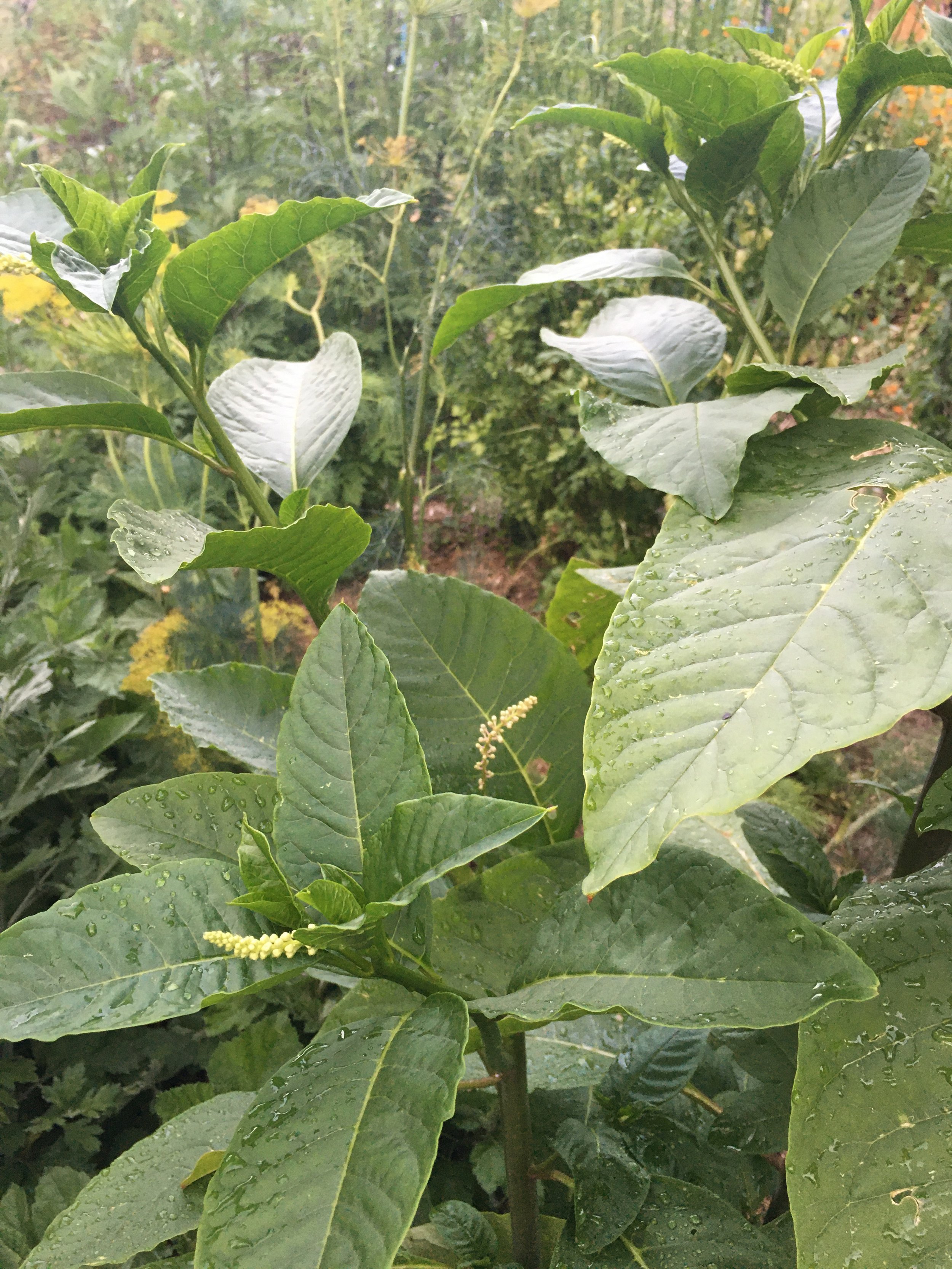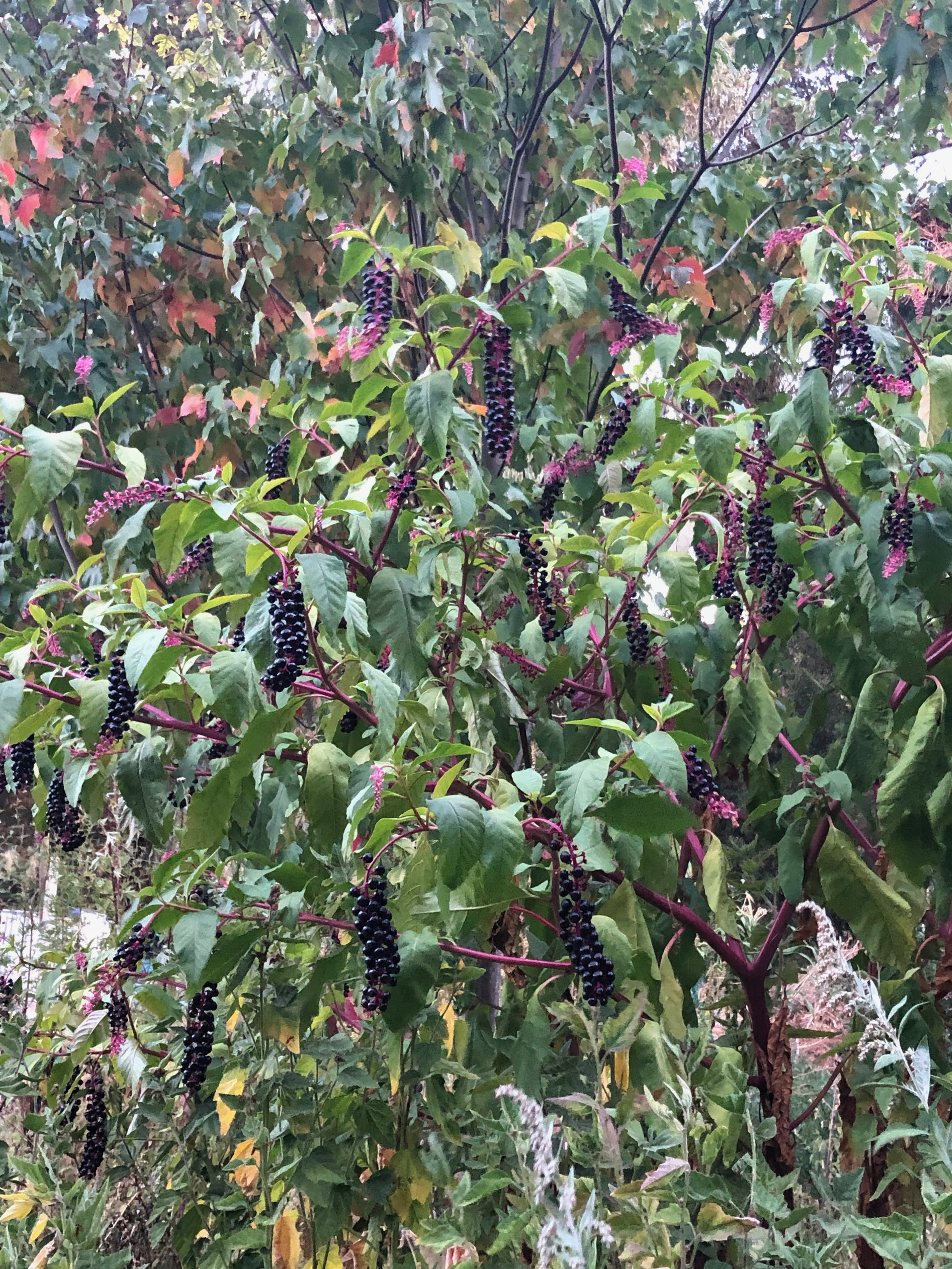 Image 1 of 4
Image 1 of 4

 Image 2 of 4
Image 2 of 4

 Image 3 of 4
Image 3 of 4

 Image 4 of 4
Image 4 of 4





Poke Seeds
Poke (Phytolacca americana)
Description:
Poke, also known as pokeweed, is a large perennial herbaceous plant native to North America and member of the Phytolaccaceae family. Poke is a robust plant that can grow up to 10 to 12 feet (3 to 3.6m) in height. It has thick, reddish-purple stems with large, oval-shaped leaves that alternate along the stem. The leaves are dark green and have a slightly rough texture. In late summer, poke produces clusters of small white flowers, which are followed by dark purple to black berries. The berries are round and juicy, containing several seeds, producing a beautiful magenta dye and ink.
NOTE: pokeweed has its name for a reason; having naturalised in many parts of the world and beloved to birds, you will find this plant popping up around your garden. Be mindful and weed out the distinguishable seedlings from undesired areas.
CAUTION: harvesting poke root for medicinal purposes should be done with caution due to its potential toxicity. The root of the poke plant contains potent compounds that can be harmful if not prepared and dosed properly. Wear protective gloves and clothing when handling poke plant parts, including the root. The sap and other parts of the plant can cause skin irritation.
Growing Conditions:
Climate: cool-temperate to subtropical; typically found in areas with mild winters and warm summers; will die back in colder climates and reshoot in the spring
Position: full sun to partial shade.
Soil: well-draining, rich, moist soil although will adapt to different soil types incl. loamy, sandy, or clay soil types; ideal soil pH should be slightly acidic to neutral, ranging from 6.0 to 7.0.
Water: moderate water needs; somewhat drought-tolerant once established.
Spacing: space the plants approximately 4 to 6 feet (120 to 180cm) apart to allow them to spread and grow to their full size.
Propagation: sow the seeds in spring, or collect ripe berries (autumn) and plant them directly in the garden; alternatively, propagate by root division in spring or autumn.
Harvest:
Root: harvest root is in late fall or early spring when the plant is dormant. At these times, the plant has stored energy in its roots. Avoid harvesting during the growing season, as the root will contain higher levels of toxins.
Berries: harvest berries when they are fully ripe and dark purple to black in colour in the autumn. The berries are not commonly used for culinary purposes due to their toxicity but can be collected for dyeing or other non-consumable purposes.
20 seeds per pack
Poke (Phytolacca americana)
Description:
Poke, also known as pokeweed, is a large perennial herbaceous plant native to North America and member of the Phytolaccaceae family. Poke is a robust plant that can grow up to 10 to 12 feet (3 to 3.6m) in height. It has thick, reddish-purple stems with large, oval-shaped leaves that alternate along the stem. The leaves are dark green and have a slightly rough texture. In late summer, poke produces clusters of small white flowers, which are followed by dark purple to black berries. The berries are round and juicy, containing several seeds, producing a beautiful magenta dye and ink.
NOTE: pokeweed has its name for a reason; having naturalised in many parts of the world and beloved to birds, you will find this plant popping up around your garden. Be mindful and weed out the distinguishable seedlings from undesired areas.
CAUTION: harvesting poke root for medicinal purposes should be done with caution due to its potential toxicity. The root of the poke plant contains potent compounds that can be harmful if not prepared and dosed properly. Wear protective gloves and clothing when handling poke plant parts, including the root. The sap and other parts of the plant can cause skin irritation.
Growing Conditions:
Climate: cool-temperate to subtropical; typically found in areas with mild winters and warm summers; will die back in colder climates and reshoot in the spring
Position: full sun to partial shade.
Soil: well-draining, rich, moist soil although will adapt to different soil types incl. loamy, sandy, or clay soil types; ideal soil pH should be slightly acidic to neutral, ranging from 6.0 to 7.0.
Water: moderate water needs; somewhat drought-tolerant once established.
Spacing: space the plants approximately 4 to 6 feet (120 to 180cm) apart to allow them to spread and grow to their full size.
Propagation: sow the seeds in spring, or collect ripe berries (autumn) and plant them directly in the garden; alternatively, propagate by root division in spring or autumn.
Harvest:
Root: harvest root is in late fall or early spring when the plant is dormant. At these times, the plant has stored energy in its roots. Avoid harvesting during the growing season, as the root will contain higher levels of toxins.
Berries: harvest berries when they are fully ripe and dark purple to black in colour in the autumn. The berries are not commonly used for culinary purposes due to their toxicity but can be collected for dyeing or other non-consumable purposes.
20 seeds per pack
Poke (Phytolacca americana)
Description:
Poke, also known as pokeweed, is a large perennial herbaceous plant native to North America and member of the Phytolaccaceae family. Poke is a robust plant that can grow up to 10 to 12 feet (3 to 3.6m) in height. It has thick, reddish-purple stems with large, oval-shaped leaves that alternate along the stem. The leaves are dark green and have a slightly rough texture. In late summer, poke produces clusters of small white flowers, which are followed by dark purple to black berries. The berries are round and juicy, containing several seeds, producing a beautiful magenta dye and ink.
NOTE: pokeweed has its name for a reason; having naturalised in many parts of the world and beloved to birds, you will find this plant popping up around your garden. Be mindful and weed out the distinguishable seedlings from undesired areas.
CAUTION: harvesting poke root for medicinal purposes should be done with caution due to its potential toxicity. The root of the poke plant contains potent compounds that can be harmful if not prepared and dosed properly. Wear protective gloves and clothing when handling poke plant parts, including the root. The sap and other parts of the plant can cause skin irritation.
Growing Conditions:
Climate: cool-temperate to subtropical; typically found in areas with mild winters and warm summers; will die back in colder climates and reshoot in the spring
Position: full sun to partial shade.
Soil: well-draining, rich, moist soil although will adapt to different soil types incl. loamy, sandy, or clay soil types; ideal soil pH should be slightly acidic to neutral, ranging from 6.0 to 7.0.
Water: moderate water needs; somewhat drought-tolerant once established.
Spacing: space the plants approximately 4 to 6 feet (120 to 180cm) apart to allow them to spread and grow to their full size.
Propagation: sow the seeds in spring, or collect ripe berries (autumn) and plant them directly in the garden; alternatively, propagate by root division in spring or autumn.
Harvest:
Root: harvest root is in late fall or early spring when the plant is dormant. At these times, the plant has stored energy in its roots. Avoid harvesting during the growing season, as the root will contain higher levels of toxins.
Berries: harvest berries when they are fully ripe and dark purple to black in colour in the autumn. The berries are not commonly used for culinary purposes due to their toxicity but can be collected for dyeing or other non-consumable purposes.
20 seeds per pack